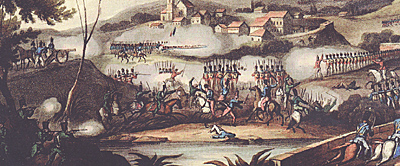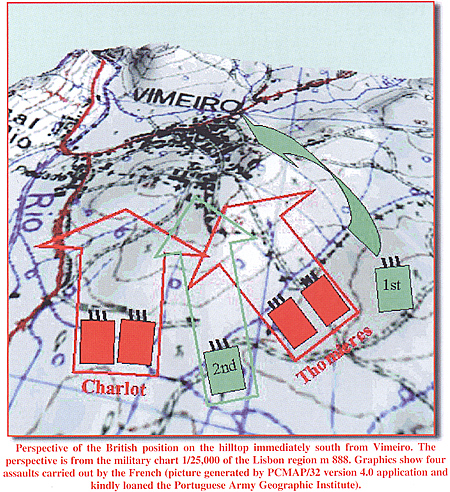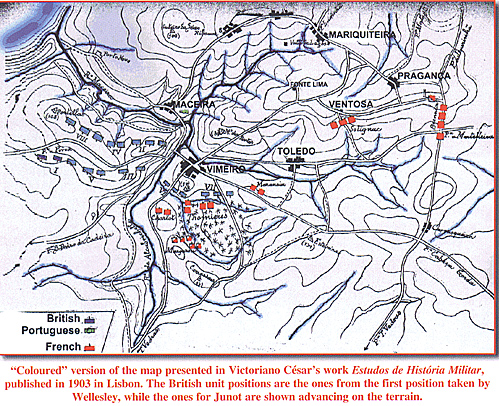Battle of Vimeiro
21 August 1808
Strategy
by Miguel Freire, Portugal
| |
On the 18th of August from a settlement called Lourinhã, Wellesley addressed a letter to the Military Secretary in order to inform him that the reinforcements were arriving in Portugal, and that the disem-barkation would take place at the Maceira beach (Porto Novo). In order that their protection could be guaranteed, Wellesley assigned, that day, all his forces to the Vimeiro region, from where they were to cover the mouth of the Ribeira de Alcobrichel (Maceira). The first reinforcements, General Anstruther's brigade (photo 1), disembarked on the 19th, while General Ackland's brigade (photo 2) only disembarked on the night of the 20th but in Paymogo, on the
mouth of the Ribeira Areia Branca, [1] about 10 km north of Maceira. Both disembarkations were troubled for some boats sank and several soldiers drowned. This reinforcement was of about 4,035 men, 2,703 from Anstruther's brigade and 1,332 from Ackland's brigade (chart 1 – British Order of Battle).
Perspective of the British position on the hilltop immediately south from Vimeiro. The perspective is from the military chart 1/25,000 of the Lisbon region m 888. Graphics show four
assaults carried out by the French (picture generated by PCMAP/32 version 4.0 application and kindly loaned the Portuguese Army Geographic Institute).
What was after all Wellesley’s strategy? His Decisive Point was to conquer Lisbon. [2] He knew exactly that the sharpest and swiftest the best. But with Ackland’s brigade came Sir Harry Burrard, one
of the several Wellesley’s superiors that were to arrive to Portugal. Though he had already prepared all the arrangements to the offensive of the 21st August, as soon as Wellesley knew of the presence of
Harry Burrard aboard the Brazen frigate near Porto Novo, he immediately went to talk with his new superior and presented him his offensive strategy:
Assuming that Junot would not attack but merely defend the Torres Vedras pass, Wellesley was planning to envelop that position by taking another path between the coast and Torres Vedras. This turning movement would be done in quick march and with a strong advanced guard in order to get to Mafra, while the main force would occupy a higher line to deter Junot’s forces retreat by Cabeço de Montachique (about 20 km south of Torres Vedras). While Wellesley was doing this, John Moore’s troops would be disembarking at the Mondego mouth and head to Santarém from where they could easily block any attempt of retreat by Junot to Spain.
Harry Burrard did not approve the strategy. He had information that John Moore’s forces were still at sea and for that reason no offensive whatsoever should be carried out until they had disembarked, Burrard had to be sure he had enough troops to beat the French. Wellesley, against his will, remained in the Vimeiro region. This region was, by nature, a stronghold offering Wellesley the proper conditions to carry out the planned mission: protect disembark at Porto Novo. On the other hand, because it was too near to sea, they had no manoeuvre space and that could be disastrous, or else, in spite of an disembark, an embark under pressure could happen, this in case the enemy would attack in all its strength and accuracy.
The scheme (map 1) chosen by Wellesley was meant to protect disembark. Therefore he assigned six brigades to the Portelas region. He made two lines; the 3rd brigade (Nightingale), the 5th brigade (Crauford) and the 1st brigade (Hill) composed one from the left to the right. The 2nd brigade (Ferguson), the 4th brigade (Bowes) and the 8th brigade (Ackland) made the second line. These brigades had with them eight artillery pieces and its advanced outposts were stationed at the S. Pedro da Caldeira path.
On the south hill of Vimeiro were the 6th brigade (Fane) and the 7th brigade (Anstruther) supported by six artillery pieces. The Anstruther’s brigade was on the left side in the church and the cemetery covering the path that led from Carrascais to the Vimeiro settlement. In the settlement were the reserves and in the valley, immediately west from Vimeiro, was the cavalry.
Near the Maceira settlement were the Portuguese infantry and part of the cavalry. Because it was considered the less likely avenue of approach of the enemy, Wellesley left the northeast flank monitored by a small group from the Portuguese infantry and some British soldiers, the path from Vimeiro to Lourinhã by Fonte de Lima and Ventosa were in this left flank. Wellesley decided not to assign the scarce cavalry he had in surveillance missions.
The French
On the day of the battle at Roliça, Junot and Loison were in Cercal. “Junot had been informed by peasants that Delaborde was fighting the British, assuming these were heading towards Lisbon, by the Torres path, while the Portuguese army would follow another path – the one that connected Rio Maior to Alcoentre. Because of Junot was more worried with the British army, he decided to attack first these and only after defeating them would he turn himself to the Portuguese army. Therefore he decided to concentrate all his troops in the Torres Vedras region”.
[3]
On the 18th of August, Junot and Loison’s division entered Torres Vedras and Delaborde joined them the day after.
The cavalry detachments only informed that the British were in the Vimeiro region and that the Portuguese were near these. Junot knew time was against him. With the time the British soon would be more, besides the fact that Lisbon had been left only with a small garrison. He needed to engage them no matter where they were or whatever they number would be.
[4]
Late afternoon on the 20th, Junot decided to move and sent all his cavalry on reconnaissance, allowing at the same time his infantry divisions to leave their position (chart 2 – French Order of Battle).
“Coloured” version of the map presented in Victoriano César’s work Estudos de História Militar, published in 1903 in Lisbon. The British unit positions are the ones from the first position taken by Wellesley, while the ones for Junot are shown advancing on the terrain. Battle of Vimeiro 21 August 1808
The Battle Junot and Wellesley Chart 1 - British Army Order of Battle Chart 2 - French Army Order of Battle Back to Table of Contents -- First Empire # 70 Back to First Empire List of Issues Back to MagWeb Master Magazine List © Copyright 2003 by First Empire. This article appears in MagWeb (Magazine Web) on the Internet World Wide Web. Other articles from military history and related magazines are available at http://www.magweb.com |
 “They will, I hope, land tomorrow.”
“They will, I hope, land tomorrow.”
 The British Strategy
The British Strategy
